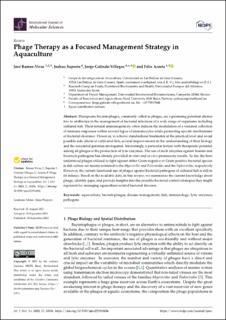| dc.contributor.author | Ramos-Vivas, José | |
| dc.contributor.author | Superio, Joshua | |
| dc.contributor.author | Galindo-Villegas, Jorge | |
| dc.contributor.author | Acosta, Felix | |
| dc.date.accessioned | 2021-11-19T09:51:14Z | |
| dc.date.available | 2021-11-19T09:51:14Z | |
| dc.date.created | 2021-09-26T15:30:20Z | |
| dc.date.issued | 2021 | |
| dc.identifier.citation | Ramos-Vivas, J., Superio, J., Galindo-Villegas, J. & Acosta, F. (2021). Phage therapy as a focused management strategy in aquaculture. International Journal of Molecular Sciences, 22(19): 10436. doi: | en_US |
| dc.identifier.issn | 1422-0067 | |
| dc.identifier.uri | https://hdl.handle.net/11250/2830441 | |
| dc.description.abstract | Therapeutic bacteriophages, commonly called phages, are a promising potential alternative to antibiotics in the management of bacterial infections of a wide range of organisms including cultured fish. Their natural immunogenicity often induces the modulation of a variated collection of immune responses within several types of immunocytes while promoting specific mechanisms of bacterial clearance. However, to achieve standardized treatments at the practical level and avoid possible side effects in cultivated fish, several improvements in the understanding of their biology and the associated genomes are required. Interestingly, a particular feature with therapeutic potential among all phages is the production of lytic enzymes. The use of such enzymes against human and livestock pathogens has already provided in vitro and in vivo promissory results. So far, the best-understood phages utilized to fight against either Gram-negative or Gram-positive bacterial species in fish culture are mainly restricted to the Myoviridae and Podoviridae, and the Siphoviridae, respectively. However, the current functional use of phages against bacterial pathogens of cultured fish is still in its infancy. Based on the available data, in this review, we summarize the current knowledge about phage, identify gaps, and provide insights into the possible bacterial control strategies they might represent for managing aquaculture-related bacterial diseases. | en_US |
| dc.language.iso | eng | en_US |
| dc.publisher | MDPI | en_US |
| dc.relation.uri | https://doi.org/10.3390/ijms221910436 | |
| dc.rights | Navngivelse 4.0 Internasjonal | * |
| dc.rights.uri | http://creativecommons.org/licenses/by/4.0/deed.no | * |
| dc.subject | Fiskeimmunologi | en_US |
| dc.subject | Fish immunology | en_US |
| dc.title | Phage therapy as a focused management strategy in aquaculture | en_US |
| dc.type | Peer reviewed | en_US |
| dc.type | Journal article | en_US |
| dc.description.version | publishedVersion | en_US |
| dc.rights.holder | © 2021 The Author(s) | en_US |
| dc.subject.nsi | VDP::Klinisk veterinærmedisinske fag: 950 | en_US |
| dc.subject.nsi | VDP::Landbruks- og Fiskerifag: 900::Fiskerifag: 920::Akvakultur: 922 | en_US |
| dc.source.volume | 22 | en_US |
| dc.source.journal | International Journal of Molecular Sciences | en_US |
| dc.source.issue | 19 | en_US |
| dc.identifier.doi | 10.3390/ijms221910436 | |
| dc.identifier.cristin | 1938680 | |
| dc.source.articlenumber | 10436 | en_US |

